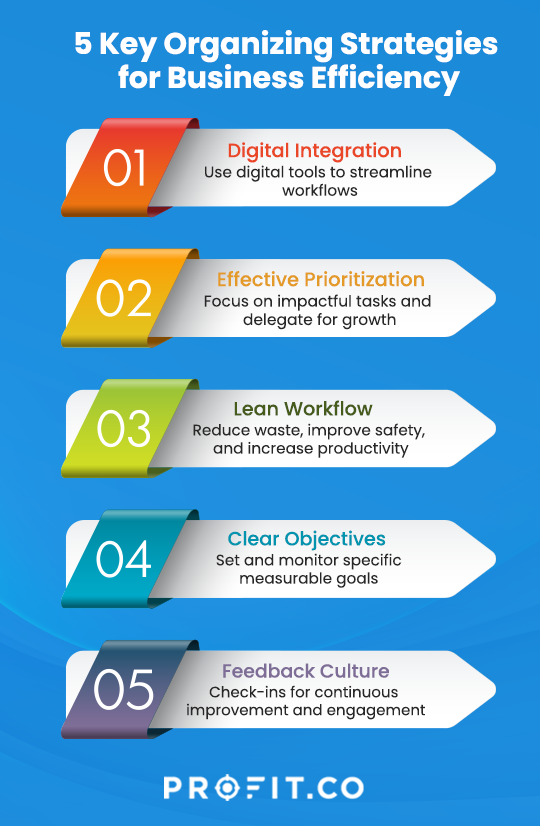For every minute spent organizing, an hour is earned. ~ Benjamin Franklin. This couldn’t be more true in the context of your business. Organization can be the heart and soul of your business. You might have a vision for what you want your business to be, but perhaps you’re still figuring out how to accomplish it. You want your employees to perform well and test their limits and creativity. Yet, you’re still navigating the best ways to harness this potential, to push their limits without breaking them. Now, consider the pivotal role of communication in this equation. Did you know that a staggering study revealed 400 companies with 100,000 employees each lost approximately $62 million annually due to ineffective communication between employees? With these concerns in mind, you’re probably asking how to organize your business successfully. It can be a lot, but don’t let yourself get overwhelmed!
The Power of Organizing Your Workflow
Organizing your workflow is not just about tidying up processes; it’s about crafting the pulse of your company’s daily operations. It’s a strategic activity that shapes your organizational culture, sets a benchmark for excellence, and dictates the rhythm at which your team operates. That is why it is important to take the time to create something unique to your business rather than following what is recommended for all businesses.
Create a workflow system tailored to your business’s unique needs and aspirations. This isn’t about unquestioningly adopting generic best practices; it’s about innovatively crafting a system that resonates with the specificities of your venture. Today’s choices in organizing your workflow are more than just procedural adjustments; they are investments in efficiency, time management, and financial prudence.
In the following sections, we’ll list some organizational strategies suitable for the forward-thinking entrepreneur. These transformative practices can redefine how you and your team achieve success.
The Art of Being Organized
The Art of Being Organized in Business often seems more daunting than it is. In many cases, the seeds of organization are sown during the very inception of your business, driven by the unique product or service you offer. This fundamental aspect defines all subsequent activities and operations. The key lies in effectively communicating your vision and objectives to your employees, ensuring that every action they take aligns with and furthers your overarching business goals.
Say you run a home renovation business. A lot of your work will depend on positive communication with your clients, who, in turn, will recommend you to others. You are about to send one of your employees to meet a customer. She asks you what to do, and you say, “Just do a good job.” Albeit a positive comment, it does not define how you expect her to work with the client. She completes the work, but you notice that the clients do not seem to be glowing with appreciation. You talk to her and find out she focused on simply meeting regulations so they couldn’t complain about quality. Good work, certainly, but not what you wanted. Next time, you outline the values you expect the work to reflect. You say, “Make it personal, tasteful, and affordable.” In a larger context, you explain the necessity beyond good quality and the need to work closely with the clients. You then take this idea and make it a company standard so that all employees understand and can teach new ones as well. As you do that, workflows will become more efficient, and you become more hands-off. Remember, it’s not about getting everything perfect from the start; it’s about being aware, adaptable, and willing to refine your strategies as you grow.
To learn more about how HR tools can improve your workflows
Getting Started with Organization
Before diving into the details, laying a strong foundation for your organizational strategy is essential. Consider these key points as your starting blocks for building a well-structured and efficient business:
- Clarify your business’s vision and purpose.
- Establish specific and measurable objectives.
- Focus on creating efficient and simple workflows.
- Foster a work environment that values clarity and purpose.
- Lead by example in organizational efforts.
- Plan with future growth and scalability in mind.
Clear Workflows for Consistency
In pursuing a focused, efficient, and rejuvenating work environment, it’s not just about the office’s physical layout but also about the structure and flow of work. Creating distinct workspaces tailored to the specific needs of different tasks can significantly enhance productivity. For instance, roles that demand creative thinking might benefit from a more relaxed, open space, encouraging brainstorming and innovation. Conversely, positions requiring uninterrupted concentration would thrive in a quieter, more isolated setting. Regardless, it’s important to keep your employees’ needs in mind.
With that said, your work environment can mean more than just the physical space. Much of today’s work is done digitally and the same principles apply there. Create different spaces for different functions. Take a finance company as an example: the nature of the work involves collecting, processing, and presenting data. By establishing clear digital workflows and creating templates for different functions, you can streamline processes, making them more efficient. This approach not only organizes the work but also respects the cognitive load of your employees. It’s about providing them with the necessary information in a structured manner, eliminating clutter, and enhancing focus. The better you understand and cater to the thought processes of your employees, the more effective these systems will be. This holistic approach to physical and digital workspace organization ensures a consistently productive and employee-friendly environment.
Out of clutter,find simplicity
Work Management Tools for Automation Success
Embracing automation is key to scaling your business in today’s fast-paced environment. With an enormous range of applications and tools available, identifying areas in your business process that are ripe for automation can bring significant efficiencies. The first step is to analyze your workflows meticulously. Where are the stopgaps in it? What tasks seem excessively repetitive and do not require much human intervention? Questions like these are only the first step but can be very impactful in making your employees’ lives easier and saving time. This initial assessment is crucial and can substantially improve efficiency and employee satisfaction.
Consider the example of HR software. Human resource management becomes increasingly complex as your company grows, but thankfully, this is a common challenge many businesses face. As a result, numerous HR tools are available that, once customized to your specific requirements, can automate many time-consuming HR tasks. Implementing such software can dramatically streamline your HR processes, saving weeks or even months of manual effort over time.
Similarly, evaluating other aspects of your business operations can reveal opportunities for automation. This could involve customer relationship management, inventory tracking, or even financial reporting. By harnessing the right tools and tailoring them to fit your unique business needs, you can not only save time and reduce costs but also free up your team to focus on more strategic, value-adding activities. It’s a shift towards smarter work management where technology plays a pivotal role in driving business efficiency and growth.
Five Key Strategies for Organizing Your Business Operations

Having explored the importance and benefits of organization in business, we now focus on practical implementation. We spotlight five essential strategies designed to streamline and enhance your business operations. Let’s delve into these transformative strategies that can redefine your business’s organizational landscape.
Embrace digital tools for efficiency
Integrating digital tools into your business operations can significantly streamline task management and coordination. These tools facilitate better project tracking, ensuring timely tasks and team members are aligned with their responsibilities. Furthermore, adopting communication platforms enhances internal dialogue and collaboration making it easier for team engagement. This digital integration is crucial for enhancing operational efficiency and ensuring smooth workflow management.
Employees should always clearly understand their place within the organizational hierarchy. This clarity is crucial, regardless of whether your structure is centralized or decentralized. Efficient communication within this structure is vital; it ensures quick resolution of queries and appropriate allocation of responsibilities. This aspect is fundamental for businesses of all sizes and is crucial in organizing and driving success.
Prioritize and delegate effectively
Adopting a prioritization model similar to Google’s, where innovative and high-impact tasks are at the forefront, combined with a delegation approach identical to Richard Branson’s decentralized style, can significantly enhance business operations. This method involves identifying key initiatives that drive growth and entrusting team members with the autonomy to execute these tasks effectively. Such a strategy streamlines workflow and builds a culture of trust and empowerment, which is essential for a dynamic and thriving team environment.
Implement a lean workflow?
Inspired by Toyota’s success with Lean methodology, focusing on eliminating waste and concentrating on value-adding activities leads to a more agile and productive business environment. This method involves identifying tasks that are overly complex or hazardous tasks and streamlining or automating them to improve safety and consistency. For instance, reorganizing tool placement or employing robotics for heavy lifting are ways to simplify complex tasks. Adopting such strategies creates a flexible manufacturing environment, adept at using advanced technology to rapidly adapt to market changes. This lean approach is more than just a manufacturing strategy; it’s a philosophy for operational excellence, emphasizing continuous improvement and efficiency across all business aspects.
Establish and monitor clear objectives
Drawing inspiration from Google and Intel’s successful use of Objectives and Key Results (OKRs), this highlights the importance of defining precise, measurable objectives and subdividing them into smaller, achievable key results and initiatives. By setting these clear targets, teams can align their daily actions with the broader company goals, ensuring a unified direction. Key results serve as milestones that track progress and offer tangible evidence of advancement towards these objectives. Additionally, aligning initiatives with these key results ensures that every task undertaken is strategically aimed at achieving the overall goals. This method not only gives teams a clear sense of purpose but also fosters motivation and a sense of accomplishment as they witness their direct impact on the company’s success.
Foster a feedback-oriented culture
By adopting a strategy similar to Pixar Animation Studios, General Electric, and Adobe Systems where regular, constructive check-ins have replaced traditional performance management methods, you can create a transformative feedback culture in your business. This approach encourages ongoing dialogue and quick adaptations, fostering a workplace that continuously evolves and improves. Engaging representatives from different departments in regular reviews brings many perspectives, encouraging a sense of ownership and inclusivity among employees. Additionally, providing a safe and accessible channel for employee feedback—whether through digital means or in a dedicated physical space—ensures everyone feels heard and connected to the company’s growth. This commitment to continuous feedback and improvement is vital in maintaining an organized, dynamic, and responsive business environment.
Conclusion
In the end, efficient organization can be approached from multiple stances, but it all serves better to customize the company for you and your employees. Well-spent time and effort can pay off in the long run, helping you build a business to last and keeping you organized for success.
A tool that helps with all this is software Profit.co offers. If you want to follow these steps, perhaps you’d like some help along the journey. Our services are readily available and proven to benefit the business as you require.

